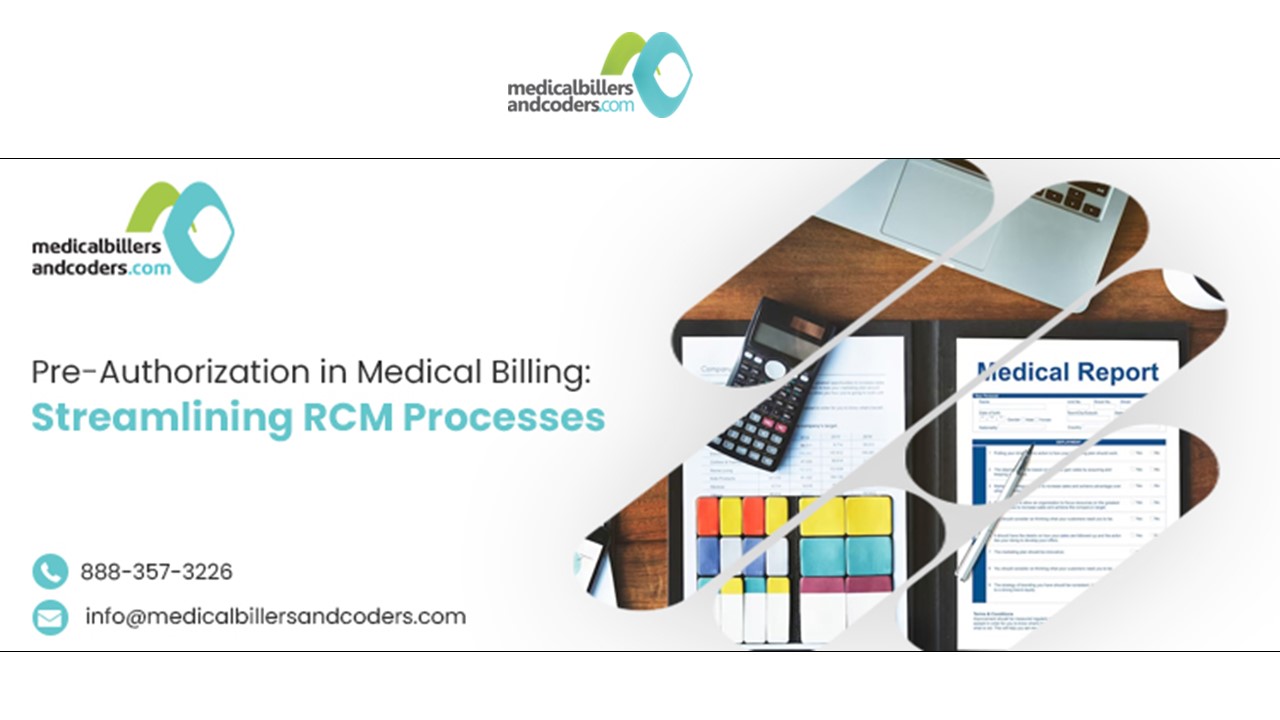Pre-Authorization in Medical Billing: Streamlining RCM Processes - PowerPoint PPT Presentation
Title:
Pre-Authorization in Medical Billing: Streamlining RCM Processes
Description:
This article explores the concept of pre-authorization in medical billing, its types, its role in the healthcare system, how it works, and its importance. – PowerPoint PPT presentation
Number of Views:1
Title: Pre-Authorization in Medical Billing: Streamlining RCM Processes
1
(No Transcript)
2
Pre-Authorization in Medical Billing
Streamlining RCM Processes
In the complex landscape of medical billing,
pre-authorization plays a crucial role in
ensuring effective communication between
healthcare providers, insurance companies, and
patients. Pre-authorization serves as a mechanism
to validate and approve medical procedures,
treatments, and services before they are
performed or availed. This article explores the
concept of pre-authorization in medical billing,
its types, its role in the healthcare system, how
it works, and the importance of partnering with
specialized pre-authorization service providers
like Medical Billers and Coders (MBC). What is
Pre-Authorization in Medical Billing? Pre-authori
zation, also known as prior authorization or
pre-certification, is a process used by
healthcare providers to obtain approval from
insurance companies before delivering certain
medical procedures, treatments, or services to
patients. It involves submitting detailed
information, such as medical records, diagnostic
reports, treatment plans, and estimated costs, to
the insurance company for review and
approval. Types of Pre-Authorization 1.
Surgical Pre-Authorization
3
Pre-Authorization in Medical Billing
Streamlining RCM Processes
Surgical pre-authorization applies to procedures
like surgeries, including elective and
non-elective operations. It ensures that the
proposed surgical procedure is medically
necessary and appropriate based on the patients
condition. 2. Diagnostic Pre-Authorization Diag
nostic pre-authorization is required for
diagnostic tests, such as MRIs, CT scans, PET
scans, and genetic testing. It ensures that these
tests are necessary for accurate diagnosis and
treatment. 3. Treatment Pre-Authorization Treat
ment pre-authorization pertains to therapies,
such as chemotherapy, radiation therapy, and
specialized treatments. It ensures that the
recommended treatment is justified, taking into
account the patients condition and previous
interventions. 4. Medication Pre-Authorization
Medication pre-authorization is necessary for
certain prescription medications, particularly
those that are
4
Pre-Authorization in Medical Billing
Streamlining RCM Processes
- expensive or have specific usage criteria. It
confirms that the prescribed medication is
appropriate and will be covered by the insurance
plan. - The Role of Pre-Authorization in Medical Billing
- Quality Control Pre-authorization acts as a
quality control measure by ensuring that the
proposed medical procedures and treatments align
with established medical guidelines, reducing the
likelihood of unnecessary or inappropriate care. - Cost Management Pre-authorization helps manage
healthcare costs by evaluating the medical
necessity and appropriateness of proposed
services. It allows insurance companies to verify
if the procedure or treatment is covered under
the patients plan and ensure that resources are
allocated efficiently. - Reducing Fraud and Abuse Pre-authorization
serves as a safeguard against fraudulent or
abusive practices by verifying the legitimacy of
the treatment and preventing unnecessary or
excessive billing. - Enhancing Patient Safety By reviewing medical
records and treatment plans, pre-authorization
helps identify potential risks and ensures
patient safety by approving appropriate
interventions and avoiding potentially harmful
procedures.
5
Pre-Authorization in Medical Billing
Streamlining RCM Processes
- How Does Pre-Authorization Work?
- The pre-authorization process typically involves
the following steps - Evaluation The healthcare provider identifies
the need for a specific procedure, treatment, or
medication. They gather relevant medical records
and documentation to support the request. - Request Submission The provider submits the
pre-authorization request to the insurance
company, including all necessary documentation.
The request details the medical necessity,
proposed procedure, and estimated costs. - Review and Decision The insurance company
reviews the request, assessing the medical
necessity, appropriateness, and coverage
eligibility. They may consult with medical
professionals or review specific criteria to make
an informed decision. - Approval or Denial Based on the review, the
insurance company communicates the decision to
the healthcare provider and the patient. If
approved, the provider can proceed with the
requested procedure or treatment. If denied, the
provider can appeal the decision or explore
alternative options.
6
Pre-Authorization in Medical Billing
Streamlining RCM Processes
- The Importance of Pre-Authorization in Medical
Billing - Financial Security Pre-authorization helps
patients understand their insurance coverage and
potential out-of-pocket expenses, reducing
financial surprises and improving transparency. - Improved Efficiency By obtaining
pre-authorization, healthcare providers can
streamline their workflows, ensuring that the
necessary approvals are in place before
delivering services. This helps avoid delays in
treatment and minimizes administrative burdens. - Reduced Reimbursement Issues Pre-authorization
reduces the risk of denied claims or
reimbursement issues since the procedure or
treatment has already received approval from the
insurance company. - Enhanced Patient Care The pre-authorization
process ensures that patients receive appropriate
and necessary care, increasing the likelihood of
positive health outcomes and reducing the
potential for complications or adverse events. - To summarize, pre-authorization in medical
billing is a critical component of revenue cycle
management, serving to validate and approve
medical procedures, treatments, and services. It
plays a significant role in controlling costs,
preventing fraud, enhancing patient safety, and
ensuring appropriate care delivery.
7
Pre-Authorization in Medical Billing
Streamlining RCM Processes
By understanding the nuances of pre-authorization
and partnering with specialized service providers
like Medical Billers and Coders (MBC), healthcare
organizations can streamline their billing
processes, improve patient care, and optimize
financial outcomes. Pre-Authorization Services
by Medical Billers and Coders (MBC) Medical
Billers and Coders (MBC) is a leading revenue
cycle management company providing complete
medical billing services including prior
authorizations. Our expertise and knowledge of
insurance policies and procedures enable us to
navigate the pre-authorization process
efficiently. MBC assists providers in accurately
documenting and submitting pre-authorization
requests, ensuring compliance with insurance
guidelines and increasing the likelihood of
approval. By outsourcing pre-authorization
services to MBC, healthcare providers can focus
on patient care while ensuring a seamless and
efficient billing process. For further
information about our prior authorization
services, please reach out via email
at info_at_medicalbillersandcoders.com or by
calling 888-357-3226.

